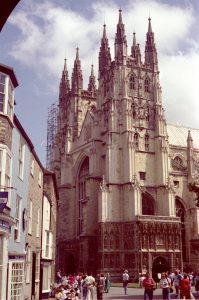The cathedral church of a diocese means the church which contains the seat or throne or cathedra of the bishop of the diocese. There are many important churches in England which are not cathedrals. The best example is Westminster Abbey which serves royal functions such as coronations and weddings but is not a cathedral.
The Church of England has a mixture of secular and monastic cathedrals as well as cathedrals that are called of the new foundation. This blog post will talk about monastic cathedrals while my previous blog post discussed secular cathedrals and my next one cathedrals of the new foundation.
In the medieval period before the reign of the Tudor King Henry VIII, the Christian church in England was loyal to the Pope in Rome. There were fewer dioceses then than one will find in the contemporary Church of England, and many of them used monastic churches to house the thrones or cathedrae of the bishops of those dioceses. The most important example was Canterbury Cathedral where there was an archbishop, but there were others: Carlisle, Durham, Ely, Norwich, Rochester, Winchester, and Worcester.
The diocese of Bath and Wells as well as that of Lichfield and Coventry were special cases. The Bishop of Bath and Wells had thrones or cathedrae in both the secular church at Wells and the monastic church at Bath. Similarly, the Bishop of Lichfield and Coventry had thrones at secular Lichfield and monastic Coventry.
All the monastic churches were priories. Most were Benedictine, but Carlisle was a priory of Augustinians. The setting for “King Richard’s Sword”, the upcoming novel in the Lady Apollonia West Country Mysteries, is Worcester where both the cathedral church and the associated priory play a role in my story.
Pictured below are the west towers of Canterbury Cathedral, the best known of the monastic cathedrals.
Tags: Chaucer's England, historical fiction, medieval mysteries